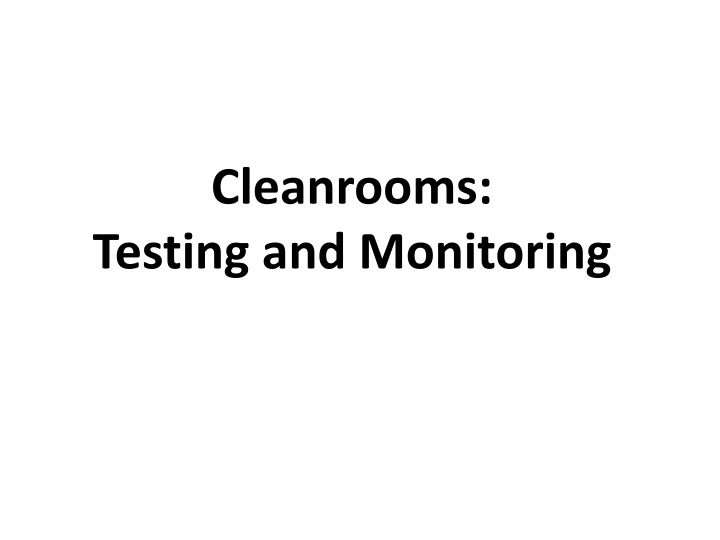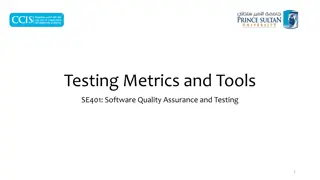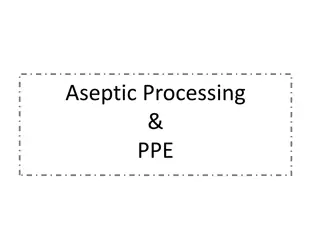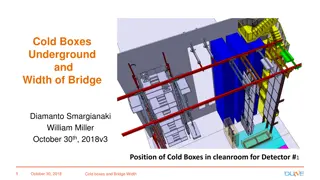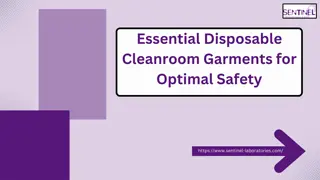Principles of Cleanroom Testing and Monitoring
Cleanrooms play a critical role in maintaining the quality of air and controlling contamination levels to ensure a sterile environment. The testing principles cover aspects such as air volume, velocity, direction, filter installation, air movement control, and additional tests like temperature and lighting levels. Understanding these principles is essential for ensuring effective cleanroom operation and compliance with quality standards.
Download Presentation

Please find below an Image/Link to download the presentation.
The content on the website is provided AS IS for your information and personal use only. It may not be sold, licensed, or shared on other websites without obtaining consent from the author.If you encounter any issues during the download, it is possible that the publisher has removed the file from their server.
You are allowed to download the files provided on this website for personal or commercial use, subject to the condition that they are used lawfully. All files are the property of their respective owners.
The content on the website is provided AS IS for your information and personal use only. It may not be sold, licensed, or shared on other websites without obtaining consent from the author.
E N D
Presentation Transcript
Cleanrooms: Testing and Monitoring
Principles of Cleanroom Testing (pt. 1) Quantity: Turbulently: dilute--air volume (supply and extract) Unidirectional: air velocity Direction (flow direction): from clean area less-clean areas to minimize the movement of contaminated air. Quality: the air will not add significantly to the contamination within the room Distribution inside cleanroom the air movement has no areas with high concentrations of contamination.
Principles of Cleanroom Testing (pt. 2) Air supply and extract quantities turbulently ventilated cleanrooms the air supply and extract volumes unidirectional airflow air velocity. Air movement control between areas: direction The pressure differences between areas are correct. The air direction through doorways, hatches, etc. is from clean to less-clean.
Principles of Cleanroom Testing (pt. 3) Filter installation leak test a damaged filter between the filter and its housing or any other part of the filter installation. Containment leak testing Contamination is not entering the cleanroom through its construction materials.
Principles of Cleanroom Testing (pt. 4) Air movement control within the room turbulently ventilated : check that there are no areas within the room with insufficient air movement. unidirectional airflow : check that the air velocity and direction throughout the room is that specified in the design. Airborne particles and microbial concentrations final measurements of the concentration of particles and micro-organisms
Additional Tests Additional tests include temperature relative humidity heating and cooling capabilities of the room sound levels lighting levels
Testing in Relation to Room Type and Occupation State The type of tests to be carried out in a cleanroom depends on whether the room is unidirectional, turbulent or mixed airflow: as-built ---in the empty room, at rest --- the room fitted with machinery but no personnel present or fully operational --- the occupancy state
Re-testing to Demonstrate Compliance Test Parameter Class Max. Time Interval To demonstrate compliance by particle counting ISO 5 6 months >ISO 5 12 months Schedule of additional tests Airflow velocity of volume All classes 12 months Air pressure difference All classes 12 months Schedule of optional tests Installed filter leakage All classes 24 months Airflow visualization All classes 24 months Recovery All classes 24 months Containment leakage All classes 24 months Schedule of tests to demonstrate continuing compliance
Monitoring of Cleanrooms Use risk assessment to decide what monitoring tests should be done and how often. The variables that are most likely to be monitored are: air pressure difference This might be necessary in high quality cleanrooms such as ISO Class 4, and better. airborne particle count This might be necessary in high quality cleanrooms such as ISO Class 4, and better. microbiological counts, as appropriate
Measurement of Air Quantities and Pressure Differences
Purpose A cleanroom must have sufficient clean air supplied to dilute and remove the airborne contamination generated within the room. Air Cleanliness: Turbulently ventilated cleanroom air supply; the more air supplied in a given time, the cleaner the room. unidirectional cleanroom air supply velocity Test: Initial testing of the design Regular intervals check
Measuring air quantities from within a cleanroom Air air filter (no diffuser) anemometer at the filter face average velocity air volume Difficulty: the non-uniformity of the air velocity inaccurate measurement Air air diffusers unevenness of air velocities incorrect air volume Hood: air supply volume average velocity measured at the exit of the hood air volume
Anemometers Anemometers: away from the filter of about 30 cm (12 inches) Vane Anemometer Principle: Air supply turning a vane frequency velocity Accuracy: velocity is less than about 0.2 m/s (40 ft/min), the mechanical friction affects the turning of the vane
Vane Anemometer Also called windmill or a propeller anemometer.
Differential Pressure Tests (pt.1) The units: Pascals are used 12 Pa = 0.05 inch water gauge Inch water column (inch WC) is a unit for pressure. It is used for measuring small pressure differences across an orifice, or in a pipeline or shaft. Inches of water can be converted to a pressure unit using the formula for pressure head. An inch of water column (iwc) is synonymous with an inch of water gauge (iwg). It is defined as the pressure exerted by a column of water of 1 inch in height at defined conditions. 1 iwg is approximately equal to 249 pascals at 0 C.
Differential Pressure Tests (pt. 2) The units: Pascals are used 12 Pa = 0.05 inch water gauge Pressure difference: 10 or 15 Pa between clean areas 15 Pa is commonly used between a cleanroom and an unclassified room 10 Pa between two cleanrooms.
Apparatus for measuring pressure differences Manometer: range of pressure difference of 0-60 Pa (0- 0.25 inch water) inclined manometer; magnehelic gauge; electronic manometer
Air Movement Control Between and Within Cleanrooms
Purposes To show that a cleanroom is working correctly, it is necessary to demonstrate that no contamination infiltrates into the cleanroom from dirtier adjacent areas. Cleanroom Containment Leak Testing Airborne contamination: doors and hatches, holes and cracks in the walls, ceilings and other parts of the cleanroom fabric
Methods of checking infiltration Smoke test (dust test) flow direction: open door, or through the cracks around a closed door, cracks at the walls, ceiling, floor and filter housings, service ducts or conduits. Difficulty where the containment originates from may be unknown, and it is often difficult to find the places to release test smoke.
Air Movement Control within a Cleanroom sufficient air movement dilute, or remove airborne contamination prevent a build-up of contamination turbulently ventilated cleanroom: good mixing, critical areas: where the product is exposed to the risk of contamination unidirectional flow cleanroom critical areas should be supplied with air coming directly from the high efficiency filters. However, problems may be encountered because of: heat rising from the machinery and disrupting the airflow obstructions preventing the supply air getting to the critical area obstructions, or the machinery shape, turning the unidirectional flow into turbulent flow contamination being entrained into the clean air.
Air Movement in turbulently ventilated rooms working well: quickly dispersed not working well Areas: not disperse quickly contamination build up improved by adjusting the air supply diffuser blades, removing an obstruction, moving a machine.
HEPA test Manufacturer's factory and packed OK Unpacked and fitted into the filter housings maybe damage Leakage problems casing housing Testing : artificial test aerosol
Leakage areas in a HEPA filter A - filter paper-to-case cement area C- gasket D - frame joints. B - filter paper (often at the paper fold)
Single Particle Counters Sample a volume of air and this is collected in a set time
Methods of Testing Filters and Filter Housings Scanning methods a probe with a photometer, or single particle counter, Scan speed : not more than 5 cm/s The most common leaks: around the periphery of the filter the casing-to-housing seal, the casing joints
Repair of leaks Filter media leak at the fold of the paper repaired on site with silicon replaced
Cleanroom test air supply volume, pressure differences, air movement within and between cleanrooms, filter integrity airborne particle concentration
Particle counter Particle counter : Both counts and sizes Photometer : Only mass of particles
Airborne particle counter: flow rate: 28 1/min (1 ft3/min) of air size range: regular 0.3 m or 0.5 m high-sensitivity: 0.1 m
Measurement of Particle Concentrations (ISO 14644-1) Principles: The number of sampling locations must reflect the size of the room and its cleanliness. The methods: (a) number of sampling locations (b) the minimum air volume
Sample locations and number (ISO standard 14644-1) Minimum number of locations: Where NL rounded up to a whole number A is the area of the cleanroom, or clean air controlled space, in m2. evenly distributed and height NL= A
Airborne sampling volume (pt. 1) Minimum volume at each location: the air volume should be large enough to count 20 particles of the largest particle size specified V= 20/C x 1000 where V is the minimum single sample volume per location, expressed in litres. C is the class limit (number of particles/m3)
Airborne sampling volume (pt. 2) One or more samples : at each location The volume sampled at each location: at least two liters The minimum sample time : at least one minute
Acceptance criteria ( ISO 14644-1) the average particle concentration at each of the particle measuring locations falls below the class limit when the total number of locations sampled is less than 10, the calculated 95% Upper Confidence Limit (UCL) of the particle concentrations is below the class limit.
Example (pt. 1) 4m x 5m size. ISO Class 3 in the 'as built' condition at a particle size of >= 0.1 m. Number of locations A= 4m x 5m. N = 4x5 = 4.47 5 The minimum number of locations is 5 Minimum air sampling volume V= 20/C x 1000 C: ISO Class 3 room is 1000/m3. Therefore: Minimum volume = 20/1000 x 1000= 20 Litres
Example (pt. 2) Particle counter flow rate of 28.3 liter/min, i.e. 20 liter, time = 42 s ISO 14644-1 requires a minimum sample time of 1 minute 1 minute
Example (pt. 3) first part of the ISO requirement is therefore satisfied(<1000). OK As less than nine samples were taken 95% UCL does not exceeded the class limit. ???
Microbial Counts People are normally the only source of micro- organisms in a cleanroom as built/ at rest little value Operational: micro-organisms are continually dispersed from people in the room.
Microbial Sampling of the Air Volumetric air sampler Settle plate sampling
Volumetric air samplers a given volume of air is sampled; also known as 'active' sampling. impact micro-organisms onto agar media; remove micro-organisms by membrane filtration.
Agar Agar: jelly-type material with nutrients added to support microbial growth. Micro-organisms landing temperature, time colony (millimetres diameter)
Settle plate sampling where micro-organisms are deposited, mainly by gravity, onto an agar plate. Impaction onto agar: inertial impaction centrifugal forces. Time and Temperature to grow Bacteria : 48 hours at 30 C to 35 C; Fungi: 72 hours at 20 C to 25 C
Centrifugal air samplers Air rotating vane centrifugal force agar surface
Membrane filtration A membrane filter is mounted in a holder vacuum draw air microbe-carrying will be filtered out by membrane The membrane placed an agar plate A membrane filter with a grid printed on the surface will assist in counting the micro- organisms.
Settle plate sampling micro-organisms skin particles 10 to 30 m by gravity onto surfaces at an average rate of about 1 cm/s Settle plate sampling: Petri dishes (diameter:90mm) containing agar medium opened and exposed time (4~5 hours) particles to deposit Petri dishes
Microbial Surface Sampling contact sampling swabbing
Contact Surface sampling Surface (flat) RODAC (Replicate Organisms Detection and Counting) dishes are used The agar is rolled over the cleanroom surface Micro-organisms stick to the agar incubated time and temperature micro-organisms grow & counted.
Swabbing uneven surfaces: bud swab rubbed surface and then rubbed over an agar plate.
